401363 Health Systems and Policy: Risk Analysis of BMP
VerifiedAdded on 2022/09/22
|7
|1533
|45
Report
AI Summary
This report presents a risk analysis of the Bonded Medical Program (BMP) in Australia, a health reform designed to address workforce shortages in rural and remote areas. The analysis identifies several key risks, including negative attitudes towards rural work, student withdrawals, reduced standards of care, high workloads, and social isolation. Each risk is assessed based on its likelihood, impact, and consequence, and appropriate risk treatment strategies are proposed. These strategies include motivating students, allocating scholarships strategically, ensuring equitable distribution of resources, providing support for medical professionals, and offering career guidance. The report emphasizes the importance of addressing these risks to ensure the success of the BMP and improve healthcare delivery in underserved communities. The report also includes a review of relevant literature and references to support the analysis and recommendations.
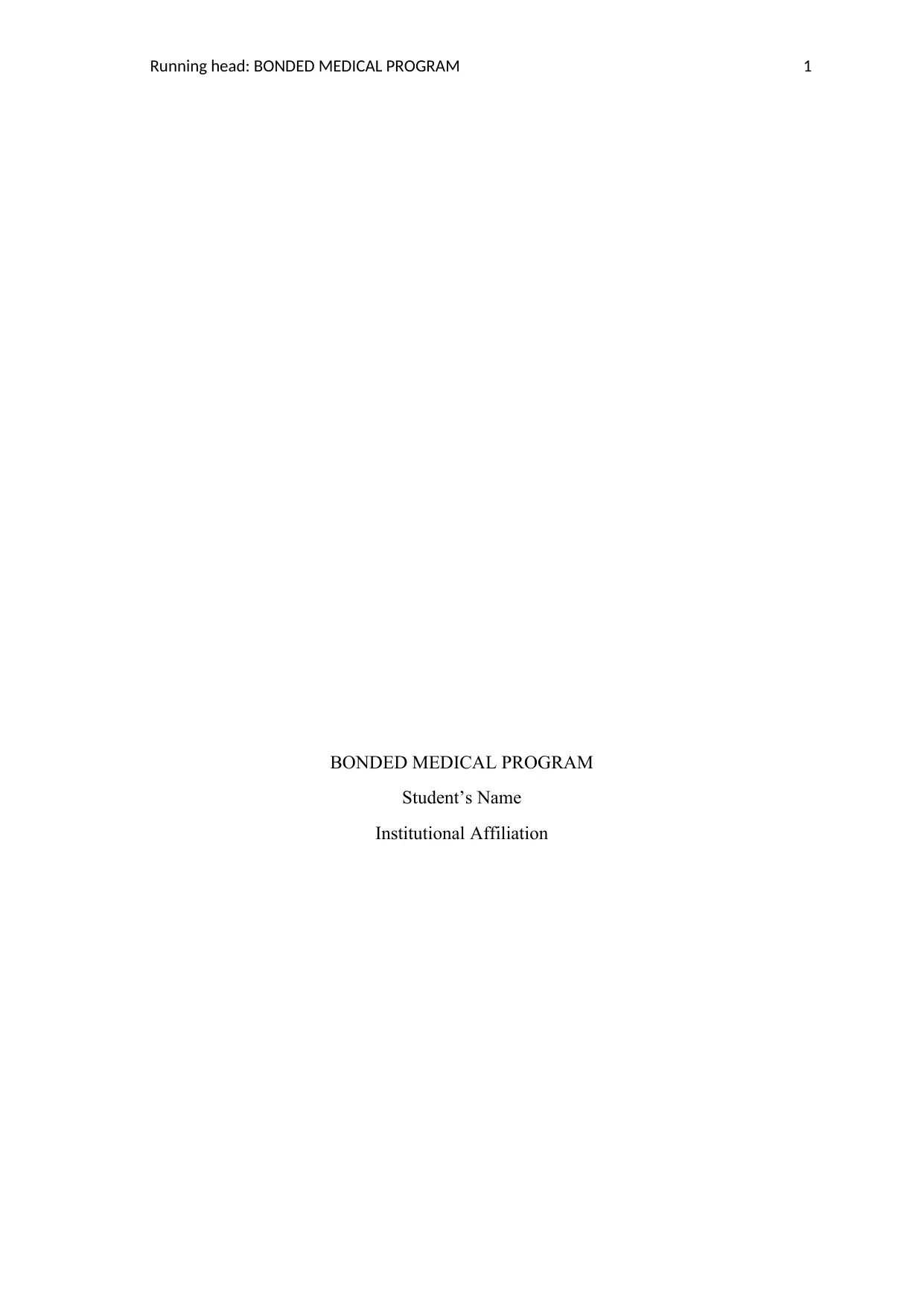
Running head: BONDED MEDICAL PROGRAM 1
BONDED MEDICAL PROGRAM
Student’s Name
Institutional Affiliation
BONDED MEDICAL PROGRAM
Student’s Name
Institutional Affiliation
Paraphrase This Document
Need a fresh take? Get an instant paraphrase of this document with our AI Paraphraser
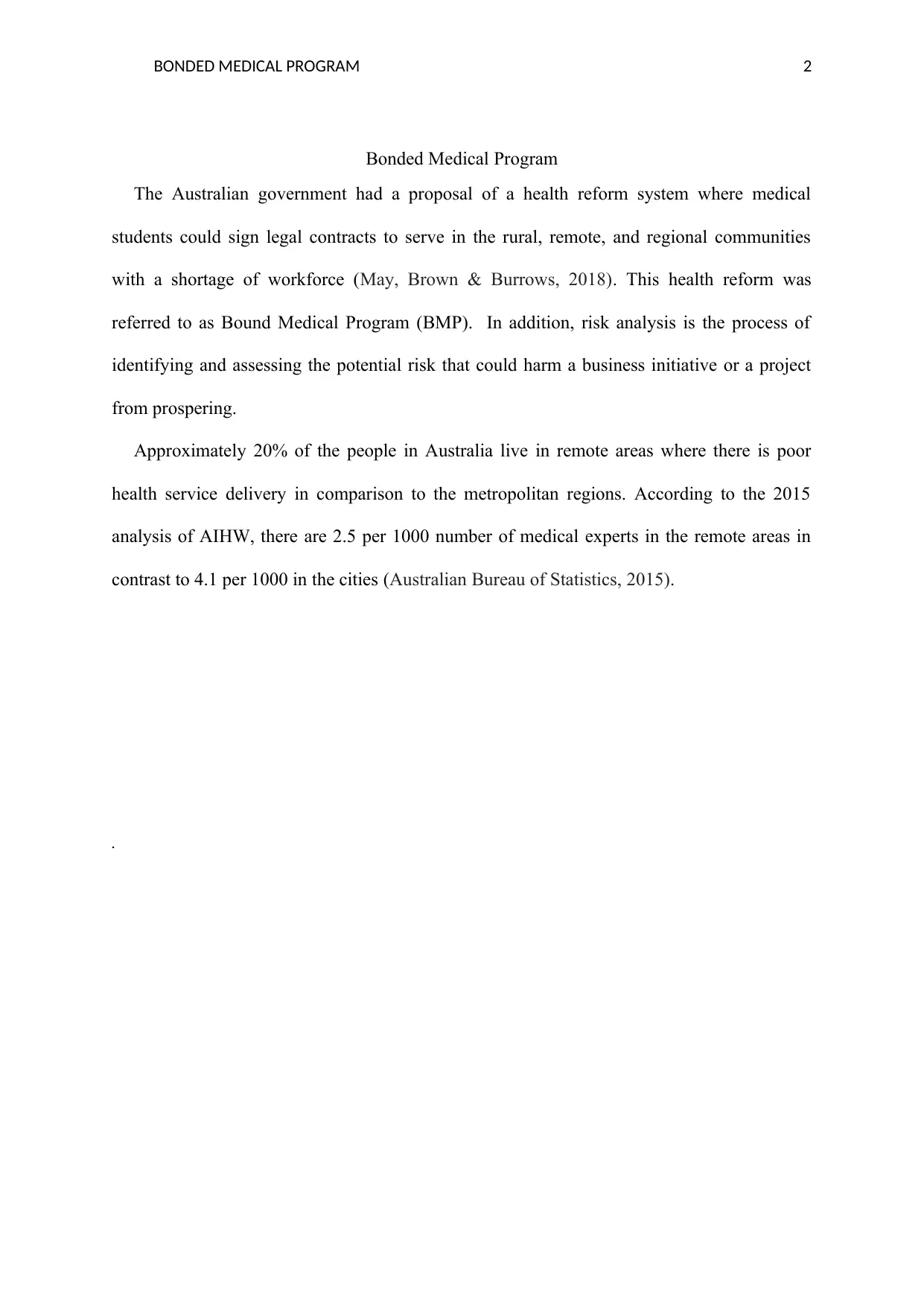
BONDED MEDICAL PROGRAM 2
Bonded Medical Program
The Australian government had a proposal of a health reform system where medical
students could sign legal contracts to serve in the rural, remote, and regional communities
with a shortage of workforce (May, Brown & Burrows, 2018). This health reform was
referred to as Bound Medical Program (BMP). In addition, risk analysis is the process of
identifying and assessing the potential risk that could harm a business initiative or a project
from prospering.
Approximately 20% of the people in Australia live in remote areas where there is poor
health service delivery in comparison to the metropolitan regions. According to the 2015
analysis of AIHW, there are 2.5 per 1000 number of medical experts in the remote areas in
contrast to 4.1 per 1000 in the cities (Australian Bureau of Statistics, 2015).
.
Bonded Medical Program
The Australian government had a proposal of a health reform system where medical
students could sign legal contracts to serve in the rural, remote, and regional communities
with a shortage of workforce (May, Brown & Burrows, 2018). This health reform was
referred to as Bound Medical Program (BMP). In addition, risk analysis is the process of
identifying and assessing the potential risk that could harm a business initiative or a project
from prospering.
Approximately 20% of the people in Australia live in remote areas where there is poor
health service delivery in comparison to the metropolitan regions. According to the 2015
analysis of AIHW, there are 2.5 per 1000 number of medical experts in the remote areas in
contrast to 4.1 per 1000 in the cities (Australian Bureau of Statistics, 2015).
.
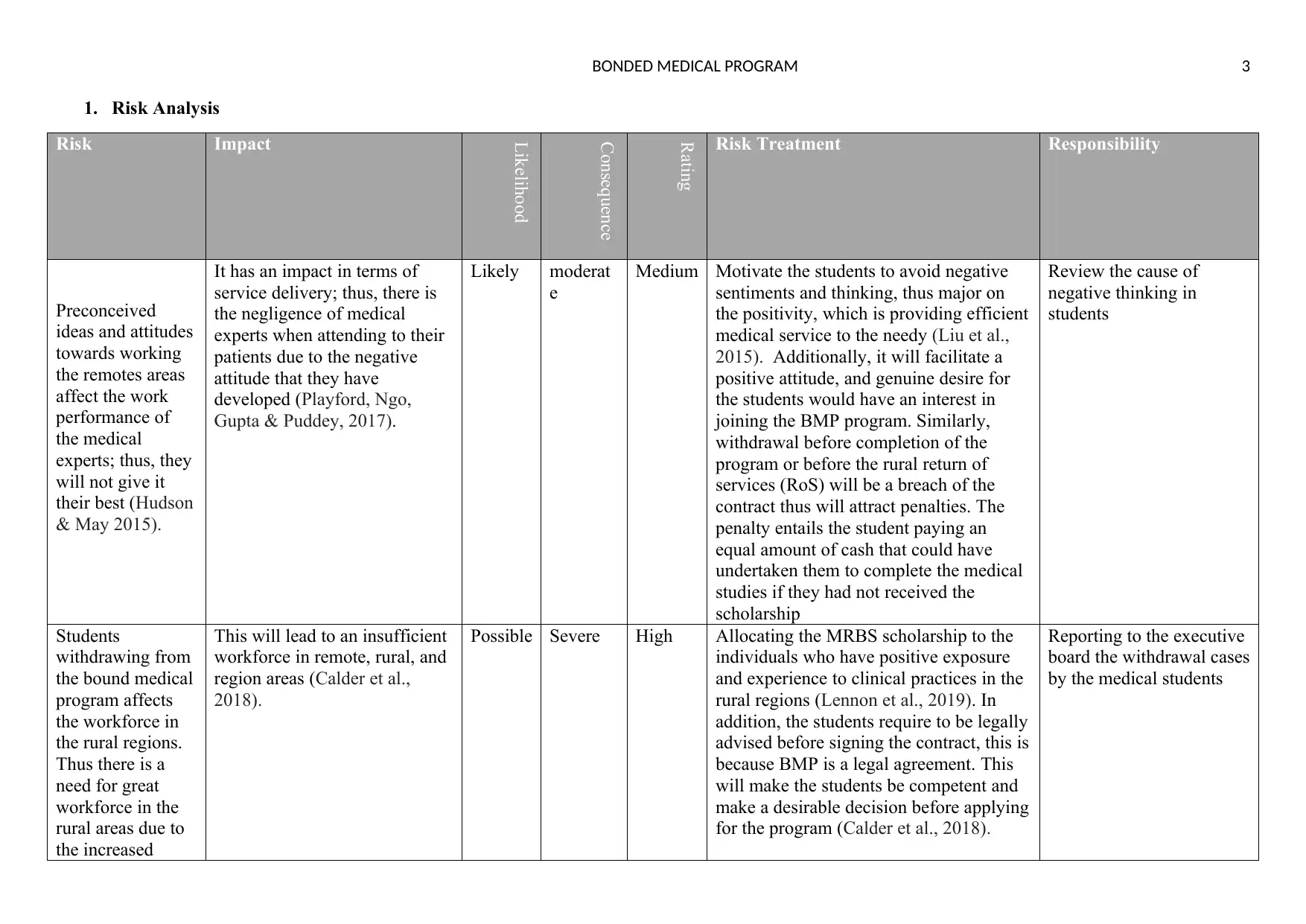
BONDED MEDICAL PROGRAM 3
1. Risk Analysis
Risk Impact
Likelihood
Consequence
Rating
Risk Treatment Responsibility
Preconceived
ideas and attitudes
towards working
the remotes areas
affect the work
performance of
the medical
experts; thus, they
will not give it
their best (Hudson
& May 2015).
It has an impact in terms of
service delivery; thus, there is
the negligence of medical
experts when attending to their
patients due to the negative
attitude that they have
developed (Playford, Ngo,
Gupta & Puddey, 2017).
Likely moderat
e
Medium Motivate the students to avoid negative
sentiments and thinking, thus major on
the positivity, which is providing efficient
medical service to the needy (Liu et al.,
2015). Additionally, it will facilitate a
positive attitude, and genuine desire for
the students would have an interest in
joining the BMP program. Similarly,
withdrawal before completion of the
program or before the rural return of
services (RoS) will be a breach of the
contract thus will attract penalties. The
penalty entails the student paying an
equal amount of cash that could have
undertaken them to complete the medical
studies if they had not received the
scholarship
Review the cause of
negative thinking in
students
Students
withdrawing from
the bound medical
program affects
the workforce in
the rural regions.
Thus there is a
need for great
workforce in the
rural areas due to
the increased
This will lead to an insufficient
workforce in remote, rural, and
region areas (Calder et al.,
2018).
Possible Severe High Allocating the MRBS scholarship to the
individuals who have positive exposure
and experience to clinical practices in the
rural regions (Lennon et al., 2019). In
addition, the students require to be legally
advised before signing the contract, this is
because BMP is a legal agreement. This
will make the students be competent and
make a desirable decision before applying
for the program (Calder et al., 2018).
Reporting to the executive
board the withdrawal cases
by the medical students
1. Risk Analysis
Risk Impact
Likelihood
Consequence
Rating
Risk Treatment Responsibility
Preconceived
ideas and attitudes
towards working
the remotes areas
affect the work
performance of
the medical
experts; thus, they
will not give it
their best (Hudson
& May 2015).
It has an impact in terms of
service delivery; thus, there is
the negligence of medical
experts when attending to their
patients due to the negative
attitude that they have
developed (Playford, Ngo,
Gupta & Puddey, 2017).
Likely moderat
e
Medium Motivate the students to avoid negative
sentiments and thinking, thus major on
the positivity, which is providing efficient
medical service to the needy (Liu et al.,
2015). Additionally, it will facilitate a
positive attitude, and genuine desire for
the students would have an interest in
joining the BMP program. Similarly,
withdrawal before completion of the
program or before the rural return of
services (RoS) will be a breach of the
contract thus will attract penalties. The
penalty entails the student paying an
equal amount of cash that could have
undertaken them to complete the medical
studies if they had not received the
scholarship
Review the cause of
negative thinking in
students
Students
withdrawing from
the bound medical
program affects
the workforce in
the rural regions.
Thus there is a
need for great
workforce in the
rural areas due to
the increased
This will lead to an insufficient
workforce in remote, rural, and
region areas (Calder et al.,
2018).
Possible Severe High Allocating the MRBS scholarship to the
individuals who have positive exposure
and experience to clinical practices in the
rural regions (Lennon et al., 2019). In
addition, the students require to be legally
advised before signing the contract, this is
because BMP is a legal agreement. This
will make the students be competent and
make a desirable decision before applying
for the program (Calder et al., 2018).
Reporting to the executive
board the withdrawal cases
by the medical students
⊘ This is a preview!⊘
Do you want full access?
Subscribe today to unlock all pages.

Trusted by 1+ million students worldwide
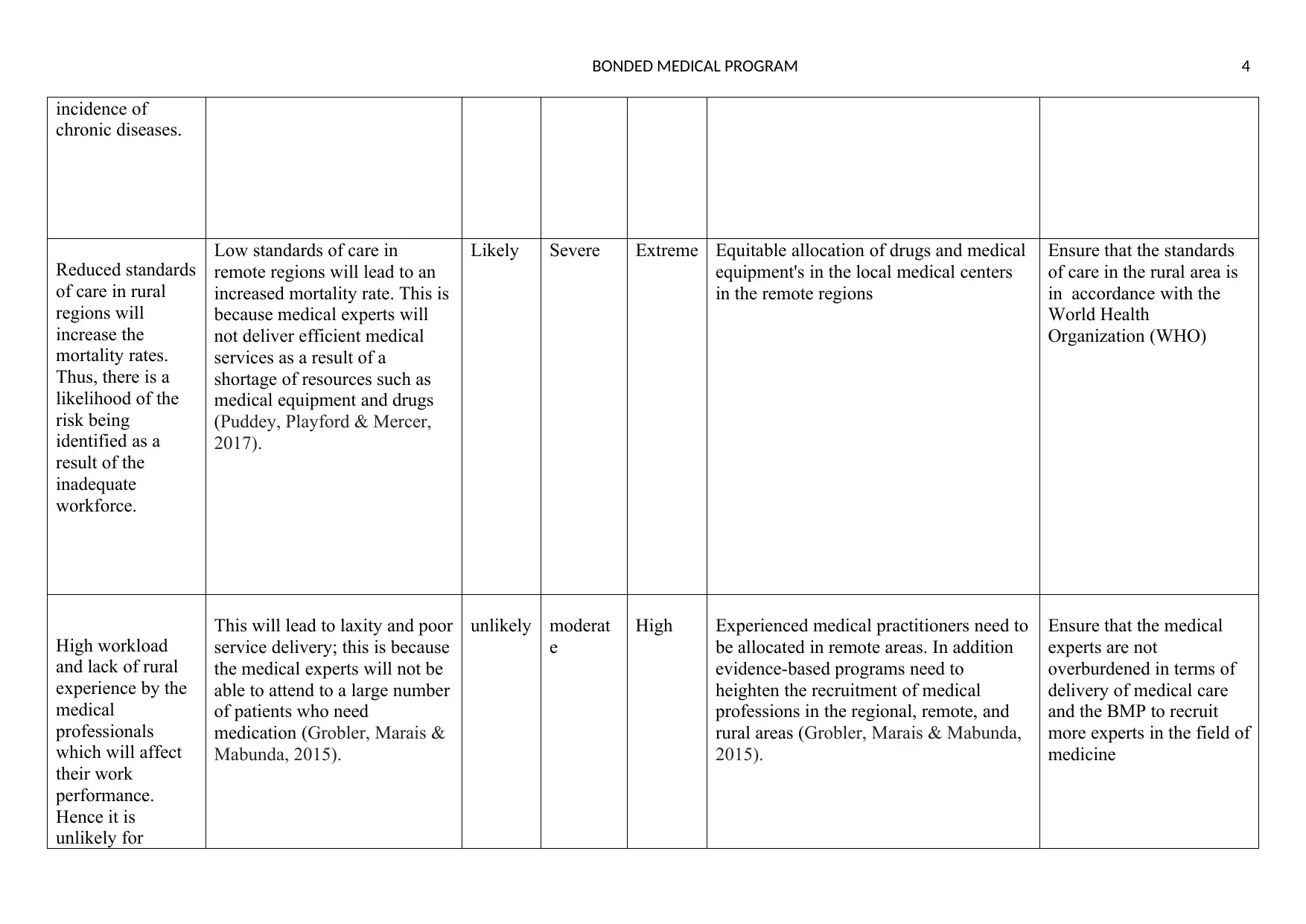
BONDED MEDICAL PROGRAM 4
incidence of
chronic diseases.
Reduced standards
of care in rural
regions will
increase the
mortality rates.
Thus, there is a
likelihood of the
risk being
identified as a
result of the
inadequate
workforce.
Low standards of care in
remote regions will lead to an
increased mortality rate. This is
because medical experts will
not deliver efficient medical
services as a result of a
shortage of resources such as
medical equipment and drugs
(Puddey, Playford & Mercer,
2017).
Likely Severe Extreme Equitable allocation of drugs and medical
equipment's in the local medical centers
in the remote regions
Ensure that the standards
of care in the rural area is
in accordance with the
World Health
Organization (WHO)
High workload
and lack of rural
experience by the
medical
professionals
which will affect
their work
performance.
Hence it is
unlikely for
This will lead to laxity and poor
service delivery; this is because
the medical experts will not be
able to attend to a large number
of patients who need
medication (Grobler, Marais &
Mabunda, 2015).
unlikely moderat
e
High Experienced medical practitioners need to
be allocated in remote areas. In addition
evidence-based programs need to
heighten the recruitment of medical
professions in the regional, remote, and
rural areas (Grobler, Marais & Mabunda,
2015).
Ensure that the medical
experts are not
overburdened in terms of
delivery of medical care
and the BMP to recruit
more experts in the field of
medicine
incidence of
chronic diseases.
Reduced standards
of care in rural
regions will
increase the
mortality rates.
Thus, there is a
likelihood of the
risk being
identified as a
result of the
inadequate
workforce.
Low standards of care in
remote regions will lead to an
increased mortality rate. This is
because medical experts will
not deliver efficient medical
services as a result of a
shortage of resources such as
medical equipment and drugs
(Puddey, Playford & Mercer,
2017).
Likely Severe Extreme Equitable allocation of drugs and medical
equipment's in the local medical centers
in the remote regions
Ensure that the standards
of care in the rural area is
in accordance with the
World Health
Organization (WHO)
High workload
and lack of rural
experience by the
medical
professionals
which will affect
their work
performance.
Hence it is
unlikely for
This will lead to laxity and poor
service delivery; this is because
the medical experts will not be
able to attend to a large number
of patients who need
medication (Grobler, Marais &
Mabunda, 2015).
unlikely moderat
e
High Experienced medical practitioners need to
be allocated in remote areas. In addition
evidence-based programs need to
heighten the recruitment of medical
professions in the regional, remote, and
rural areas (Grobler, Marais & Mabunda,
2015).
Ensure that the medical
experts are not
overburdened in terms of
delivery of medical care
and the BMP to recruit
more experts in the field of
medicine
Paraphrase This Document
Need a fresh take? Get an instant paraphrase of this document with our AI Paraphraser
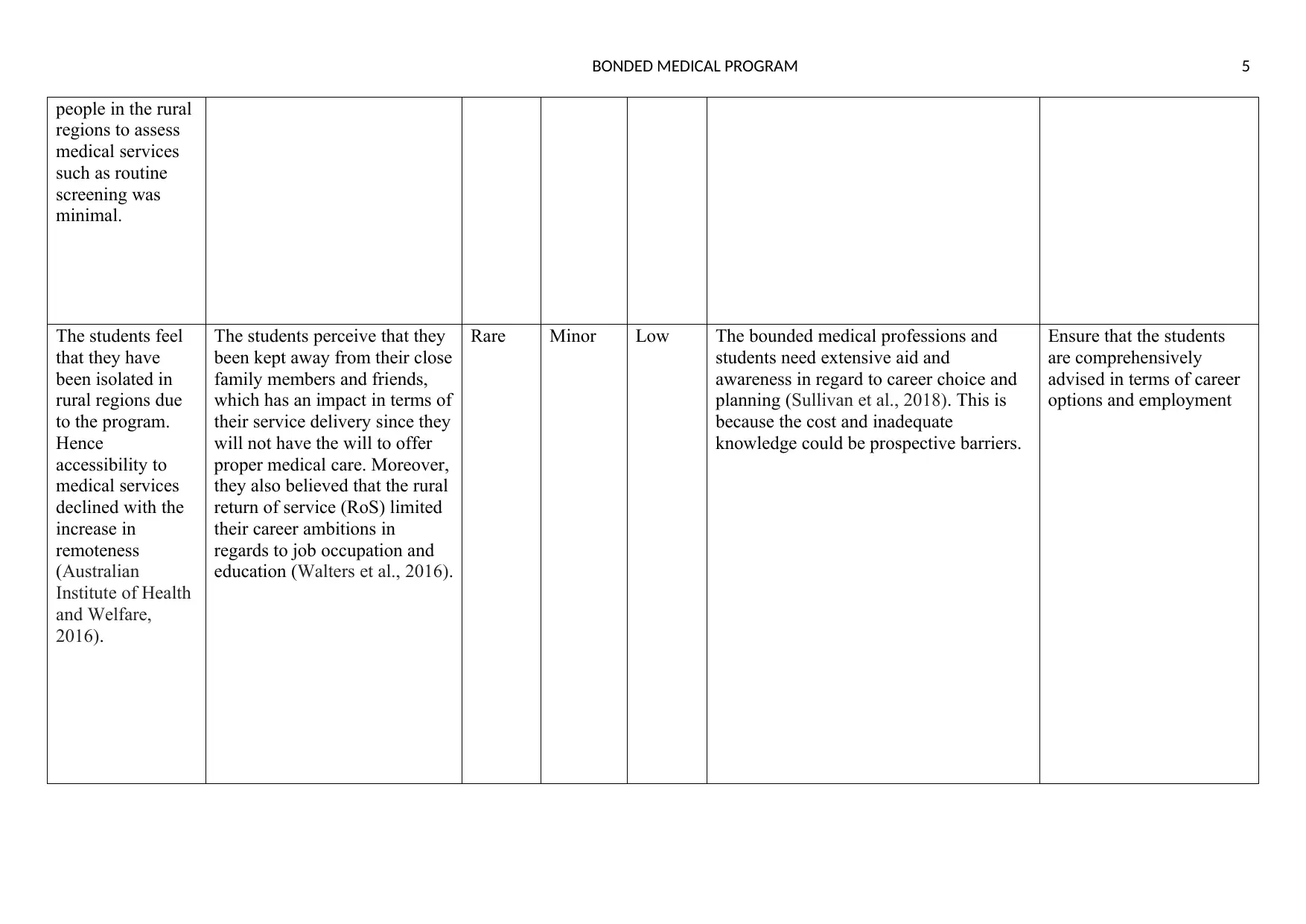
BONDED MEDICAL PROGRAM 5
people in the rural
regions to assess
medical services
such as routine
screening was
minimal.
The students feel
that they have
been isolated in
rural regions due
to the program.
Hence
accessibility to
medical services
declined with the
increase in
remoteness
(Australian
Institute of Health
and Welfare,
2016).
The students perceive that they
been kept away from their close
family members and friends,
which has an impact in terms of
their service delivery since they
will not have the will to offer
proper medical care. Moreover,
they also believed that the rural
return of service (RoS) limited
their career ambitions in
regards to job occupation and
education (Walters et al., 2016).
Rare Minor Low The bounded medical professions and
students need extensive aid and
awareness in regard to career choice and
planning (Sullivan et al., 2018). This is
because the cost and inadequate
knowledge could be prospective barriers.
Ensure that the students
are comprehensively
advised in terms of career
options and employment
people in the rural
regions to assess
medical services
such as routine
screening was
minimal.
The students feel
that they have
been isolated in
rural regions due
to the program.
Hence
accessibility to
medical services
declined with the
increase in
remoteness
(Australian
Institute of Health
and Welfare,
2016).
The students perceive that they
been kept away from their close
family members and friends,
which has an impact in terms of
their service delivery since they
will not have the will to offer
proper medical care. Moreover,
they also believed that the rural
return of service (RoS) limited
their career ambitions in
regards to job occupation and
education (Walters et al., 2016).
Rare Minor Low The bounded medical professions and
students need extensive aid and
awareness in regard to career choice and
planning (Sullivan et al., 2018). This is
because the cost and inadequate
knowledge could be prospective barriers.
Ensure that the students
are comprehensively
advised in terms of career
options and employment
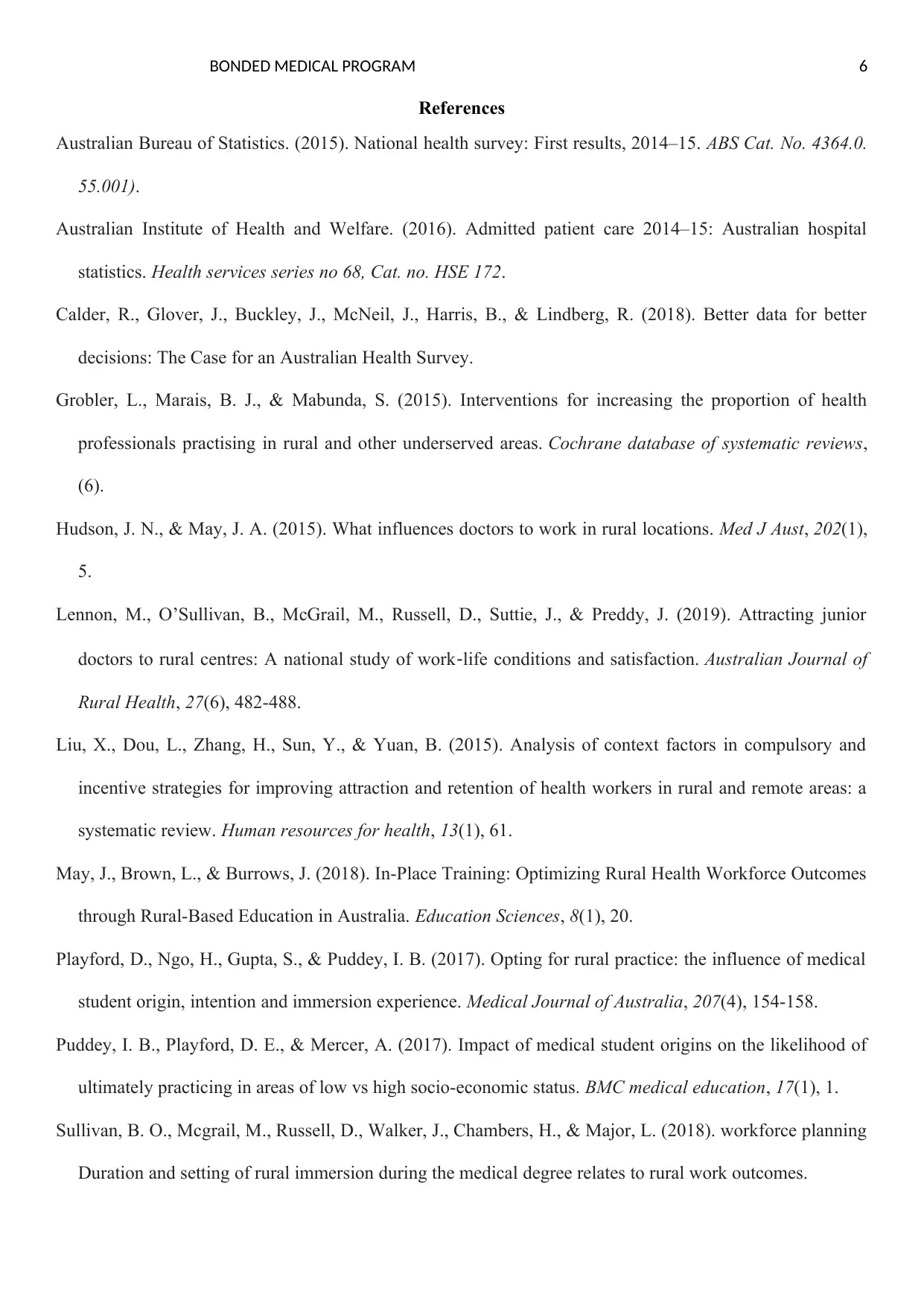
BONDED MEDICAL PROGRAM 6
References
Australian Bureau of Statistics. (2015). National health survey: First results, 2014–15. ABS Cat. No. 4364.0.
55.001).
Australian Institute of Health and Welfare. (2016). Admitted patient care 2014–15: Australian hospital
statistics. Health services series no 68, Cat. no. HSE 172.
Calder, R., Glover, J., Buckley, J., McNeil, J., Harris, B., & Lindberg, R. (2018). Better data for better
decisions: The Case for an Australian Health Survey.
Grobler, L., Marais, B. J., & Mabunda, S. (2015). Interventions for increasing the proportion of health
professionals practising in rural and other underserved areas. Cochrane database of systematic reviews,
(6).
Hudson, J. N., & May, J. A. (2015). What influences doctors to work in rural locations. Med J Aust, 202(1),
5.
Lennon, M., O’Sullivan, B., McGrail, M., Russell, D., Suttie, J., & Preddy, J. (2019). Attracting junior
doctors to rural centres: A national study of work‐life conditions and satisfaction. Australian Journal of
Rural Health, 27(6), 482-488.
Liu, X., Dou, L., Zhang, H., Sun, Y., & Yuan, B. (2015). Analysis of context factors in compulsory and
incentive strategies for improving attraction and retention of health workers in rural and remote areas: a
systematic review. Human resources for health, 13(1), 61.
May, J., Brown, L., & Burrows, J. (2018). In-Place Training: Optimizing Rural Health Workforce Outcomes
through Rural-Based Education in Australia. Education Sciences, 8(1), 20.
Playford, D., Ngo, H., Gupta, S., & Puddey, I. B. (2017). Opting for rural practice: the influence of medical
student origin, intention and immersion experience. Medical Journal of Australia, 207(4), 154-158.
Puddey, I. B., Playford, D. E., & Mercer, A. (2017). Impact of medical student origins on the likelihood of
ultimately practicing in areas of low vs high socio-economic status. BMC medical education, 17(1), 1.
Sullivan, B. O., Mcgrail, M., Russell, D., Walker, J., Chambers, H., & Major, L. (2018). workforce planning
Duration and setting of rural immersion during the medical degree relates to rural work outcomes.
References
Australian Bureau of Statistics. (2015). National health survey: First results, 2014–15. ABS Cat. No. 4364.0.
55.001).
Australian Institute of Health and Welfare. (2016). Admitted patient care 2014–15: Australian hospital
statistics. Health services series no 68, Cat. no. HSE 172.
Calder, R., Glover, J., Buckley, J., McNeil, J., Harris, B., & Lindberg, R. (2018). Better data for better
decisions: The Case for an Australian Health Survey.
Grobler, L., Marais, B. J., & Mabunda, S. (2015). Interventions for increasing the proportion of health
professionals practising in rural and other underserved areas. Cochrane database of systematic reviews,
(6).
Hudson, J. N., & May, J. A. (2015). What influences doctors to work in rural locations. Med J Aust, 202(1),
5.
Lennon, M., O’Sullivan, B., McGrail, M., Russell, D., Suttie, J., & Preddy, J. (2019). Attracting junior
doctors to rural centres: A national study of work‐life conditions and satisfaction. Australian Journal of
Rural Health, 27(6), 482-488.
Liu, X., Dou, L., Zhang, H., Sun, Y., & Yuan, B. (2015). Analysis of context factors in compulsory and
incentive strategies for improving attraction and retention of health workers in rural and remote areas: a
systematic review. Human resources for health, 13(1), 61.
May, J., Brown, L., & Burrows, J. (2018). In-Place Training: Optimizing Rural Health Workforce Outcomes
through Rural-Based Education in Australia. Education Sciences, 8(1), 20.
Playford, D., Ngo, H., Gupta, S., & Puddey, I. B. (2017). Opting for rural practice: the influence of medical
student origin, intention and immersion experience. Medical Journal of Australia, 207(4), 154-158.
Puddey, I. B., Playford, D. E., & Mercer, A. (2017). Impact of medical student origins on the likelihood of
ultimately practicing in areas of low vs high socio-economic status. BMC medical education, 17(1), 1.
Sullivan, B. O., Mcgrail, M., Russell, D., Walker, J., Chambers, H., & Major, L. (2018). workforce planning
Duration and setting of rural immersion during the medical degree relates to rural work outcomes.
⊘ This is a preview!⊘
Do you want full access?
Subscribe today to unlock all pages.

Trusted by 1+ million students worldwide
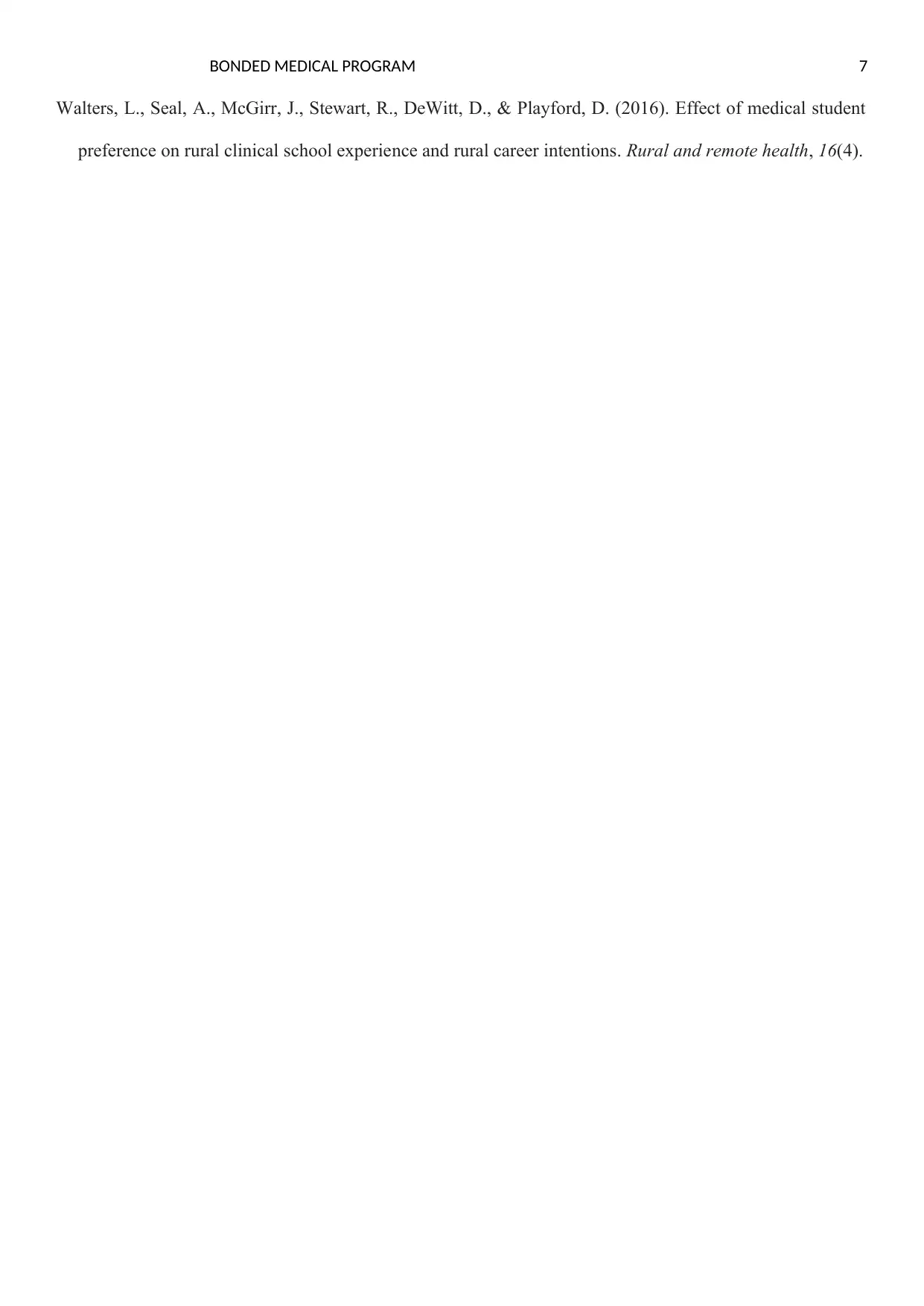
BONDED MEDICAL PROGRAM 7
Walters, L., Seal, A., McGirr, J., Stewart, R., DeWitt, D., & Playford, D. (2016). Effect of medical student
preference on rural clinical school experience and rural career intentions. Rural and remote health, 16(4).
Walters, L., Seal, A., McGirr, J., Stewart, R., DeWitt, D., & Playford, D. (2016). Effect of medical student
preference on rural clinical school experience and rural career intentions. Rural and remote health, 16(4).
1 out of 7
Your All-in-One AI-Powered Toolkit for Academic Success.
+13062052269
info@desklib.com
Available 24*7 on WhatsApp / Email
![[object Object]](/_next/static/media/star-bottom.7253800d.svg)
Unlock your academic potential
Copyright © 2020–2025 A2Z Services. All Rights Reserved. Developed and managed by ZUCOL.


